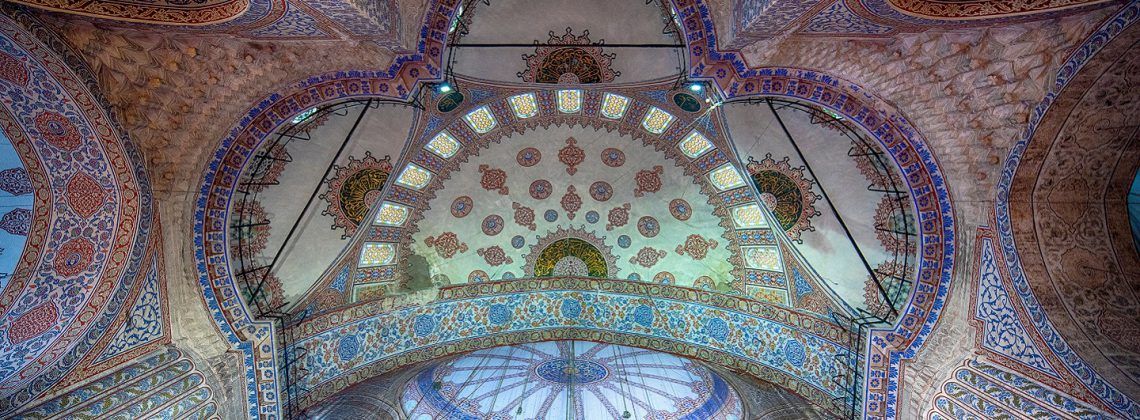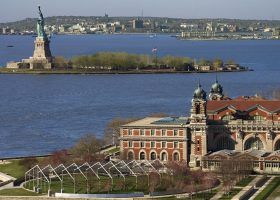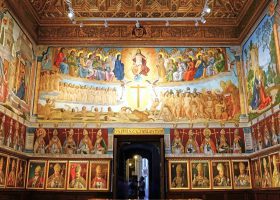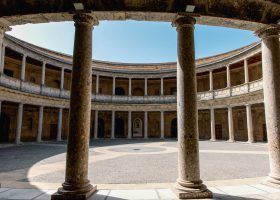The Blue Mosque in Istanbul is one of the most stunning buildings in Istanbul. Keep reading if you want to see the most impressive architectural features and understand its fascinating, intricate history! Here are the things you must see at the Blue Mosque.
Pro Tip: Planning your trip to Istanbul? Bookmark this post in your browser so you can easily find it when you’re in the city. See our guide to the top foods in Istanbul, our favorite things to do, or book a tour of Istanbul’s top attractions.
What You Have to See at the Blue Mosque in Istanbul
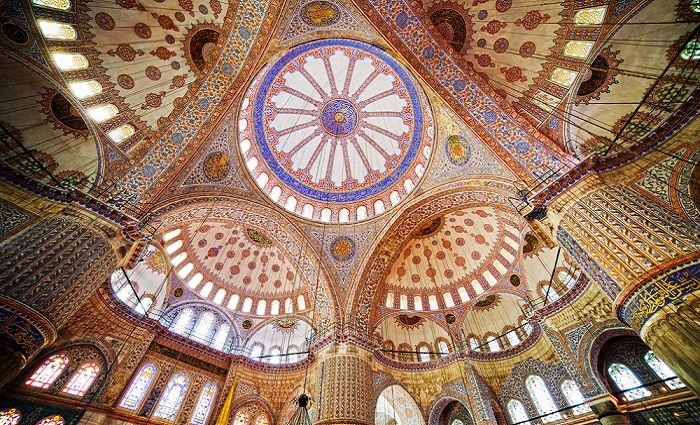
The Blue Mosque, or the Sultan Ahmed Mosque (Sultanahmet Camii in Turkish), is a UNESCO World Heritage site located in the old city of Istanbul. It’s probably the most famous mosque in the Middle East thanks to the unique, hand-painted blue (Iznik) tiles which give it the famous blue color.
The Blue Mosque is a feat of Ottoman architecture with many domes and minarets accenting the skyline. Based on original historic documents, it was first built between 1609 and 1616 during the reign of Ottoman Sultan Ahmed I. He commissioned the Blue Mosque to contrast the Byzantine Hagia Sophia. Moreover architects demolished the last of the Byzantine hippodrome in order to complete the construction.
Since the Blue Mosque is still an active place of prayer and worship, there are a few things to keep in mind before visiting. First, there are suggested dress requirements: covered head and shoulders for women, below-the-knee clothing for men, and removed shoes before entering the prayer room.
Second, be sure to avoid visiting at prayer times when the mosque is closed to the public. Prayers occur at early morning, midday, midafternoon, and evening.
Pro Tip: Your best bet for entry is in the morning before 11:30 am. Be sure to check their website if you are not a morning person for all other entry times!
9. Stand in Sultanahmet Square
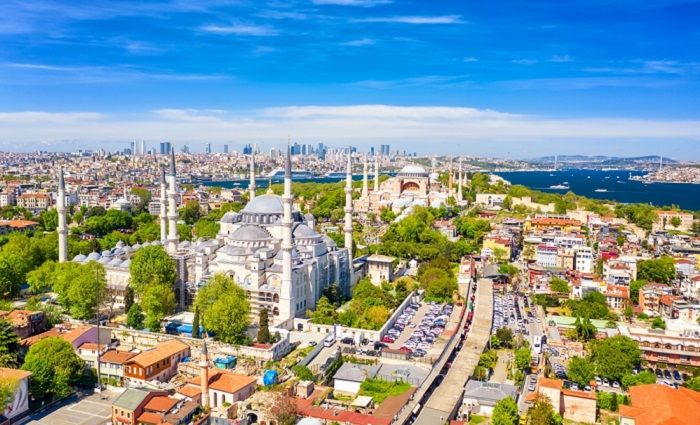
Historic District | Hippodrome | Ottoman Period
Before even entering the Blue Mosque, make sure to take in the views in the square! From the steps of this beautiful building, you can see the Byzantine hippodrome, which was constructed in the 4th century by Constantine. In addition, you can spot the Hagia Sophia not too far away.
Sultanahmet square is also where you can access the most visited historical sites in Istanbul. These including the Hagia Sophia, Topkapi Palace, the Basilica Cistern, and the Blue Mosque. So, thanks to its location, it’s the perfect place to see all of the intersections of history in Istanbul!
Not ready to book a tour? Check out our Istanbul Guide for more resources.
8. Find the Heavy Iron Chain
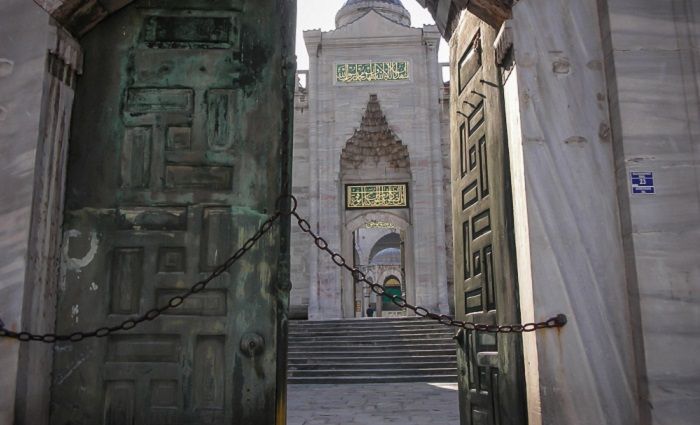
Prayer | Entrance | Bowing
There are multiple entrances to the Blue Mosque from Sultanahmet Square, but the most fascinating includes a peculiar feature that’s worth seeing. The western entrance to the courtyard has a heavy iron chain that you can see from the street, even if the entrance is closed. It hangs surprisingly low in front of the doors.
Many different reasons exist for this chain’s presence. If you ask a local like we have, the most mentioned reason is that the chain forced the Sultan to lower his head. We know from historical texts that the Sultan often arrived on horseback.
The chain hung low enough that it forced even him to bow. With a lowered head, he was ready for prayer—an important characteristic for Muslim worship.
7. Head to the Mihrab
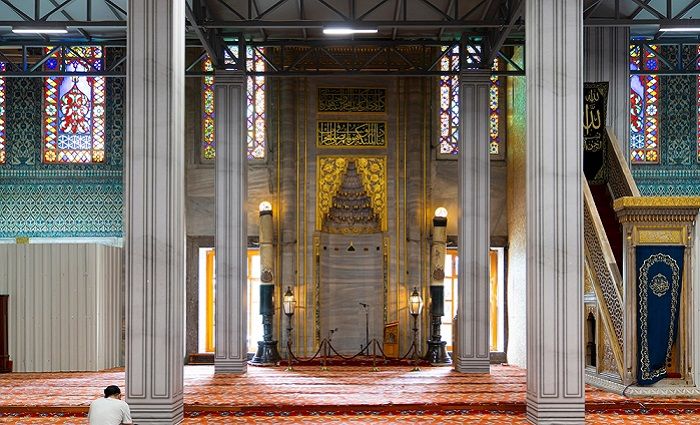
Religious Spaces | Mecca | Qibla
One of the most culturally and religiously important features within the mosque is the mihrab. It is a carved niche in the wall that worshiping Muslims face to pray (the qibla). A mihrab serves as the focal point of Islamic religious buildings and should always be something to see when you visit a mosque.
The mihrab at the Blue Mosque is carved from Proconnesian marble and is surrounded by a double panel of inscriptions with Quranic verses. This, though, is not the only example of Quranic verses in the building. Be sure to look out for more verses on the pillars in the main prayer room and on many of the blue tiles!
6. Be Wowed by the Stained-Glass Windows
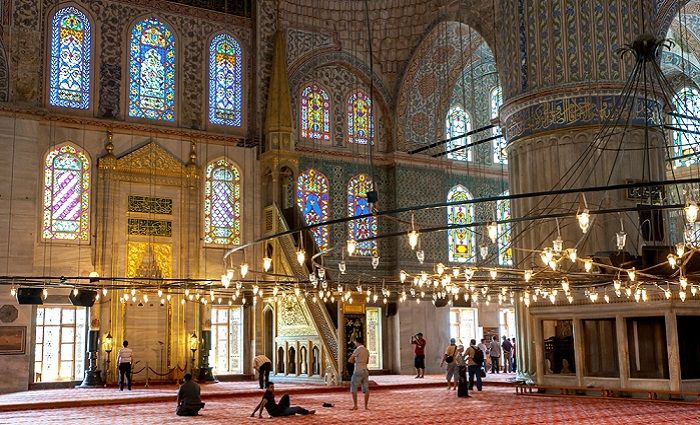
Stained Glass | Natural Light | Reproductions
It might surprise you to learn that the interior of the mosque is quite well lit. This is due, in large part, to the many windows present throughout the building. In total, there are around 260 stunning stained-glass windows that allow natural light to cascade inside.
According to Istanbul scholar J. Freely, the windows were originally Turkish stained glass. Over time, these were replaced with windows of a lower quality stained glass than the originals. However, this does not take away from the beauty of the mosque in the softened sunlight!
Not ready to book a tour? Check out our Istanbul Guide for more resources.
5. The Decorative Chandeliers
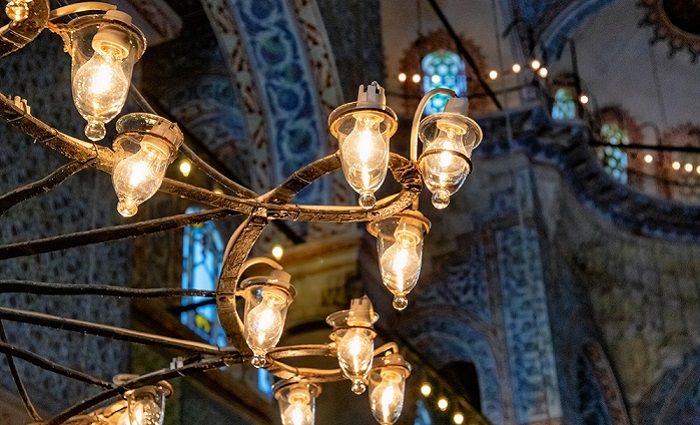
Lamps | Chandeliers | Ostrich Eggs
Although there are many windows that allow natural light into the Blue Mosque, several elaborate chandeliers and lamps provide additional lighting. The chandeliers are a main feature in the middle of the prayer room. At one point, the lights were covered in gems and gold, however, today they are a bit more plain. Nevertheless, they are still stunning pieces to see here.
A sharp-eyed observer might notice a couple of the light fixtures have preserved ostrich eggs. Why? Well, using ostrich eggs was more than just an artistic choice. According to Mimar Sinan, a famous 16th-century Ottoman architect, they were considered a spider repellent.
And what’s even more fascinating is that ostrich eggs are still used in parts of Turkey today for this reason! There is no scientific evidence for ostrich egg’s effectiveness as a bug repellent, but it makes for an interesting architectural piece and story.
4. See The Towering Minarets
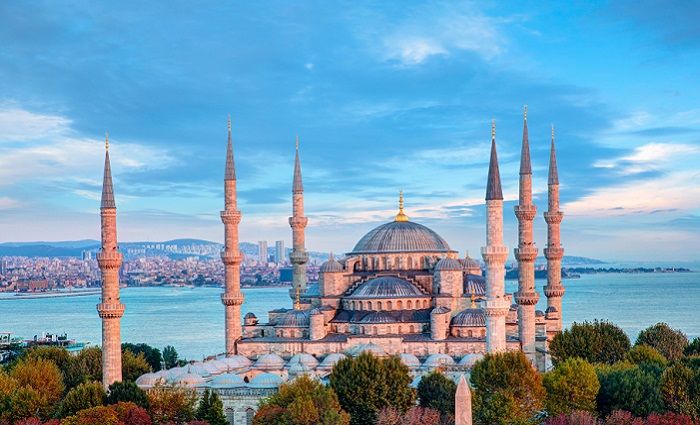
Minarets | Architecture | Mecca
The architecture of a mosque is distinctive—both inside and out. When you approach the Blue Mosque for the first time, the minarets are one of the most obvious features since you’ll see them towering above the ground.
Most mosques have a single minaret from which the Muslim call to prayer is projected. However, Islamic art historian Gülru Necipoğlu states that Ottoman sultans placed multiple minarets at mosques built during their reigns to show off their political power.
The Blue Mosque is the first Ottoman imperial mosque with six minarets. Four minarets are located at the four corners and two more are at the east and west corners of the courtyard.
The only other mosque you can find with more than six is the famous Great Mosque in Mecca. Oral tradition tells us that Sultan Ahmet I added a seventh to this location in Mecca to preserve its grandeur and status as the most important mosque—although this may be false according to Ottoman historian Godfrey Goodwin.
3. Explore the Intricate Courtyard
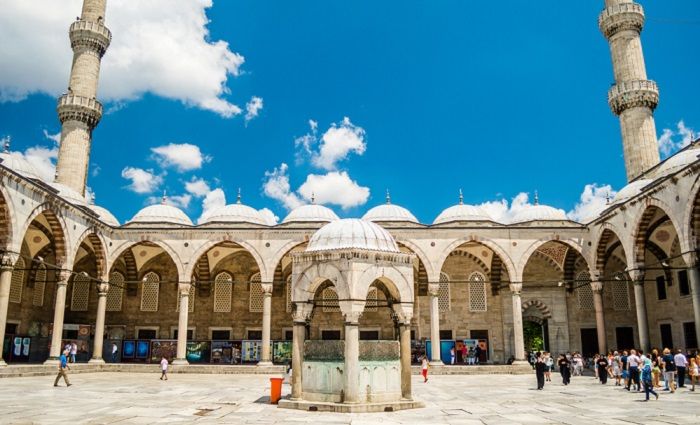
Outdoor | Flowers | Arches
When you visit the Blue Mosque, you’ll enter through one of three gates in the front which puts you right in the main courtyard. Despite being a waiting point to get into the prayer room, the courtyard is one of the most interesting architectural features to see at the Blue Mosque.
The spacious courtyard contains many interesting features to explore and see. First, look at how it’s surrounded by low, arched walls. Second, note the size—the dimensions are the same as the interior prayer room. This is only one of many repeated patterns found here. Parallels were very important, and you can also see balance in the number of minarets and domes on each side of the mosque and the use of similar geometric patterns both inside and outside.
Third, a fountain decorated with floral motifs (specifically tulips and carnations) sits in the middle of the courtyard. You’ll find these florals throughout the building too. Even though the fountain is currently only decorative, at one point, worshipers used it as part of the ceremonial cleansing before entering the mosque.
2. Feel Inspired Under the Main Dome
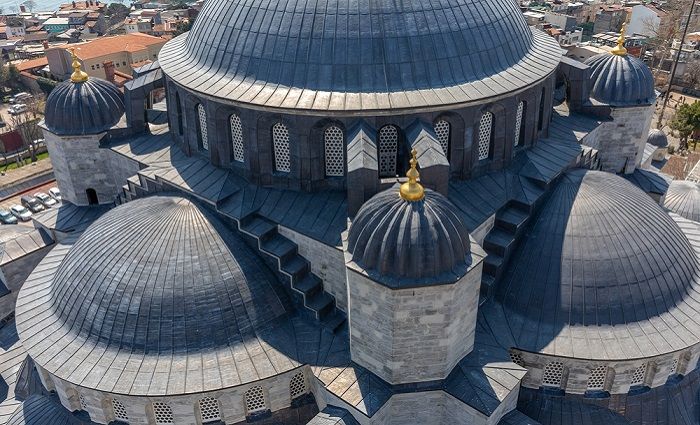
Domes | Calligraphy | Tiles
Besides the minarets, the most apparent feature to see here is the vibrant domes. The main dome is the largest and is surrounded by four smaller domes and another eight secondary domes. In total, there are 12 domes to see at the Blue Mosque.
Wondering what room is under the biggest dome? It’s the main room in the interior—the prayer room. According to records of the restoration work done on the mosque, this dome is 77 feet (23.5 meters) in diameter and 141 feet (43 meters) high. Four larger, free-standing columns (nicknamed “elephant feet” in Turkish) support the central dome and are visible in the interior of the mosque.
There are 12 types of marble used in the construction of the mosque and domes. Cafer Efendi, an Ottoman-period writer, has described them as twelve modes of music created by the hammers of the stonemasons. Together they create the full masterpiece of this magnificent mosque.
What else can you see here in the main dome? Well, the names of the various caliphs and Quranic verses are inscribed in calligraphy on the walls. You might not understand the language, but you can certainly appreciate the beauty of the script.
Pro Tip: Seyyid Kasim Gubari did the initial calligraphy at the time of construction. Contemporary documents from that era say he was one of the greatest calligraphers of his time.
1. Count the Blue Iznik Ceramic Tiles
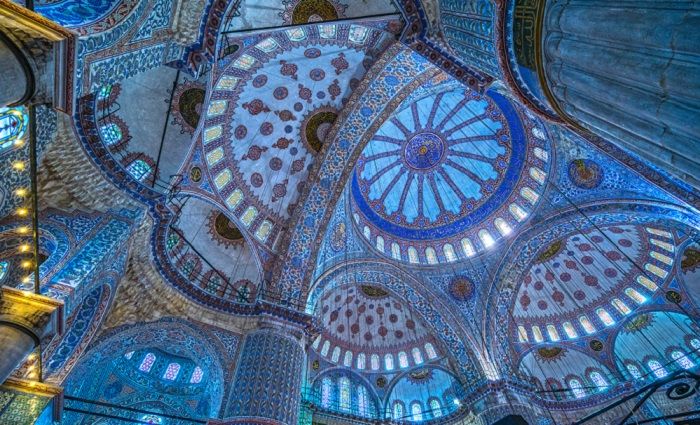
Main Dome | Blue Ceramic Tiles | Iznik
Without doubt, the most famous feature and the top thing to see at the Blue Mosque is its blue interior created by thousands of tiny blue tiles. Also called Iznik tiles, artists painted them a distinctive blue color with various geometric and floral motifs. The town of Iznik, 56 miles (90 km) southeast of modern Istanbul, gives its name to this famous ceramic style.
According to the official count during the 2014 restoration of the Blue Mosque, there are 23,000 tiles present in the building! The tiles at the lower levels of the building are more geometric and traditionally styled. In contrast, those at the gallery level have more flowers and fruits painted on them.
Interestingly, you can estimate the tile’s installation date based on its intricacy. Cafer Efendi, the biographer of the mosque’s architect, noted that the price of the tiles increased during the construction of the mosque. Therefore, the tiles became simpler later in the construction to save on costs.
Pro Tip: You can find modern Iznik ceramic tiles in shops in the Grand Bazaar, about a 15-minute walk from the Blue Mosque.
Not ready to book a tour? Check out our Istanbul Guide for more resources.
